Community Health Systems: Analysis of Nurse Burnout and Policy Report
VerifiedAdded on 2021/05/27
|10
|3155
|45
Report
AI Summary
This report examines the issue of nurse burnout within Community Health Systems (CHS), a major healthcare organization. It identifies depression and burnout as significant health problems among nurses, exacerbated by long working hours and demanding work environments. The report analyzes the urgency of addressing this issue, highlighting its impact on patient safety, satisfaction, and nurse well-being. It advocates for policy changes, including reduced working hours and increased staffing, and proposes recommendations for government intervention, such as training programs and stress management sessions. The report concludes with a call to action to address the negative consequences of nurse burnout, including low-quality services and potential nurse attrition, and emphasizes the need for policy implementation to improve working conditions and patient care within CHS.
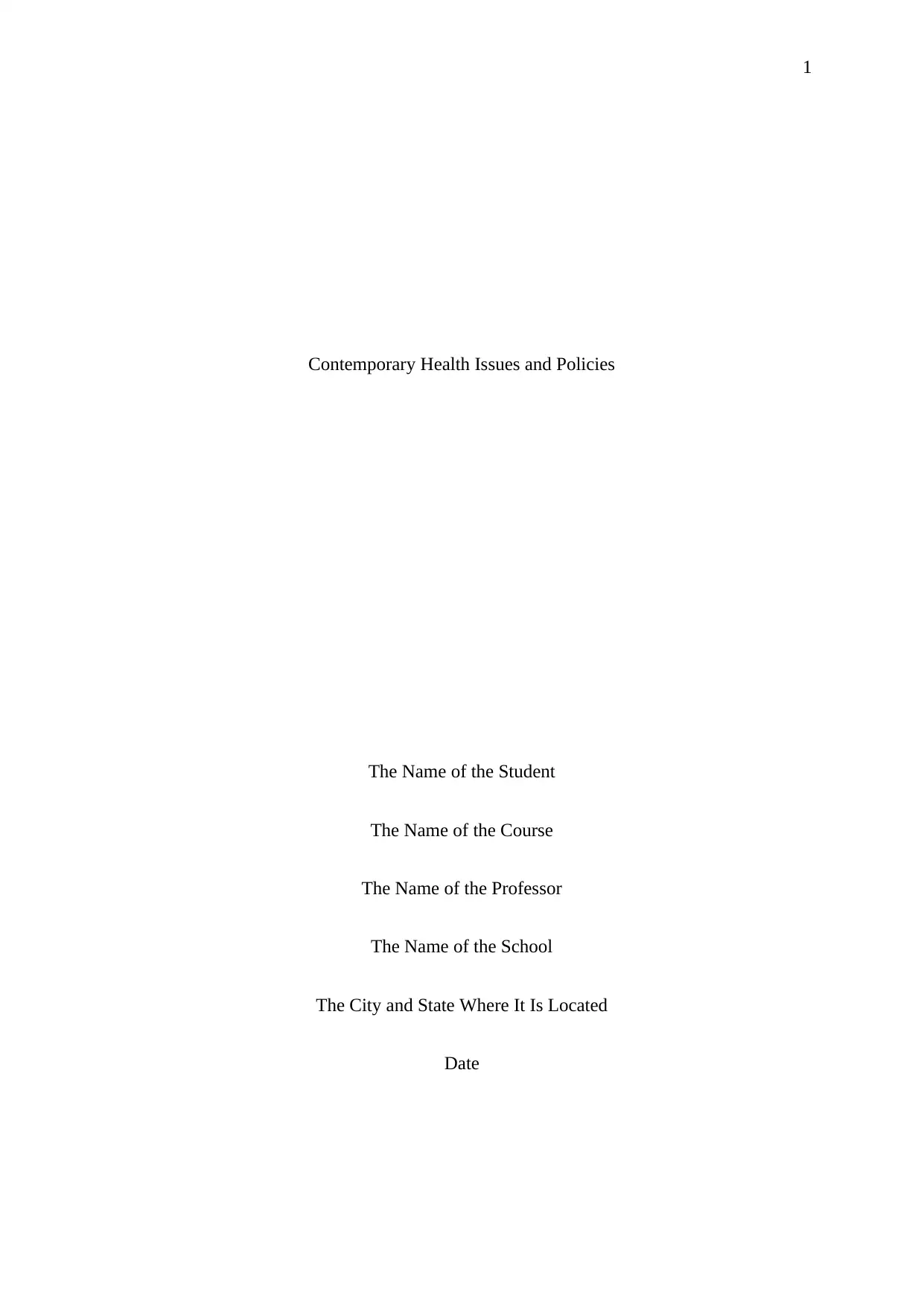
1
Contemporary Health Issues and Policies
The Name of the Student
The Name of the Course
The Name of the Professor
The Name of the School
The City and State Where It Is Located
Date
Contemporary Health Issues and Policies
The Name of the Student
The Name of the Course
The Name of the Professor
The Name of the School
The City and State Where It Is Located
Date
Paraphrase This Document
Need a fresh take? Get an instant paraphrase of this document with our AI Paraphraser
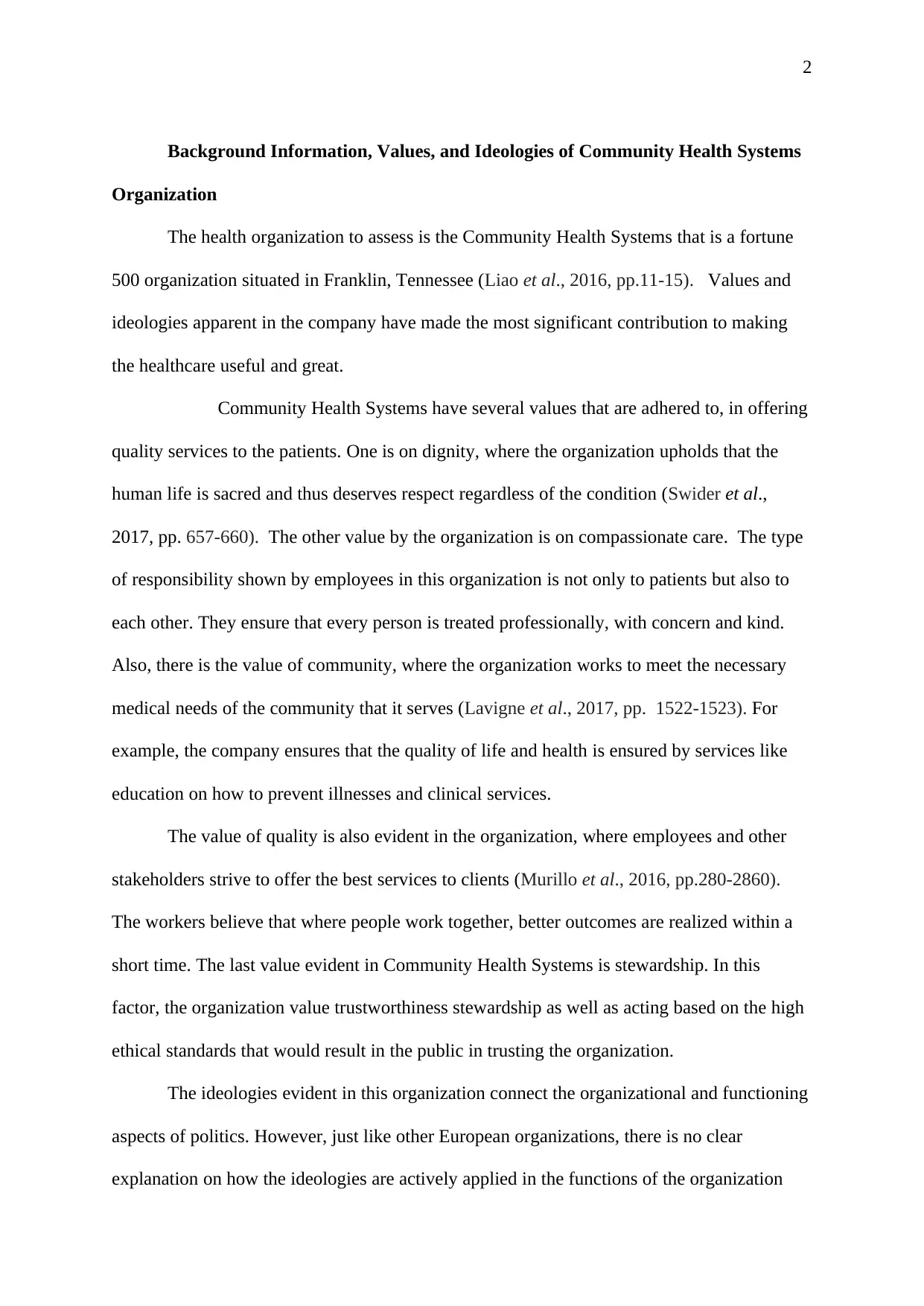
2
Background Information, Values, and Ideologies of Community Health Systems
Organization
The health organization to assess is the Community Health Systems that is a fortune
500 organization situated in Franklin, Tennessee (Liao et al., 2016, pp.11-15). Values and
ideologies apparent in the company have made the most significant contribution to making
the healthcare useful and great.
Community Health Systems have several values that are adhered to, in offering
quality services to the patients. One is on dignity, where the organization upholds that the
human life is sacred and thus deserves respect regardless of the condition (Swider et al.,
2017, pp. 657-660). The other value by the organization is on compassionate care. The type
of responsibility shown by employees in this organization is not only to patients but also to
each other. They ensure that every person is treated professionally, with concern and kind.
Also, there is the value of community, where the organization works to meet the necessary
medical needs of the community that it serves (Lavigne et al., 2017, pp. 1522-1523). For
example, the company ensures that the quality of life and health is ensured by services like
education on how to prevent illnesses and clinical services.
The value of quality is also evident in the organization, where employees and other
stakeholders strive to offer the best services to clients (Murillo et al., 2016, pp.280-2860).
The workers believe that where people work together, better outcomes are realized within a
short time. The last value evident in Community Health Systems is stewardship. In this
factor, the organization value trustworthiness stewardship as well as acting based on the high
ethical standards that would result in the public in trusting the organization.
The ideologies evident in this organization connect the organizational and functioning
aspects of politics. However, just like other European organizations, there is no clear
explanation on how the ideologies are actively applied in the functions of the organization
Background Information, Values, and Ideologies of Community Health Systems
Organization
The health organization to assess is the Community Health Systems that is a fortune
500 organization situated in Franklin, Tennessee (Liao et al., 2016, pp.11-15). Values and
ideologies apparent in the company have made the most significant contribution to making
the healthcare useful and great.
Community Health Systems have several values that are adhered to, in offering
quality services to the patients. One is on dignity, where the organization upholds that the
human life is sacred and thus deserves respect regardless of the condition (Swider et al.,
2017, pp. 657-660). The other value by the organization is on compassionate care. The type
of responsibility shown by employees in this organization is not only to patients but also to
each other. They ensure that every person is treated professionally, with concern and kind.
Also, there is the value of community, where the organization works to meet the necessary
medical needs of the community that it serves (Lavigne et al., 2017, pp. 1522-1523). For
example, the company ensures that the quality of life and health is ensured by services like
education on how to prevent illnesses and clinical services.
The value of quality is also evident in the organization, where employees and other
stakeholders strive to offer the best services to clients (Murillo et al., 2016, pp.280-2860).
The workers believe that where people work together, better outcomes are realized within a
short time. The last value evident in Community Health Systems is stewardship. In this
factor, the organization value trustworthiness stewardship as well as acting based on the high
ethical standards that would result in the public in trusting the organization.
The ideologies evident in this organization connect the organizational and functioning
aspects of politics. However, just like other European organizations, there is no clear
explanation on how the ideologies are actively applied in the functions of the organization
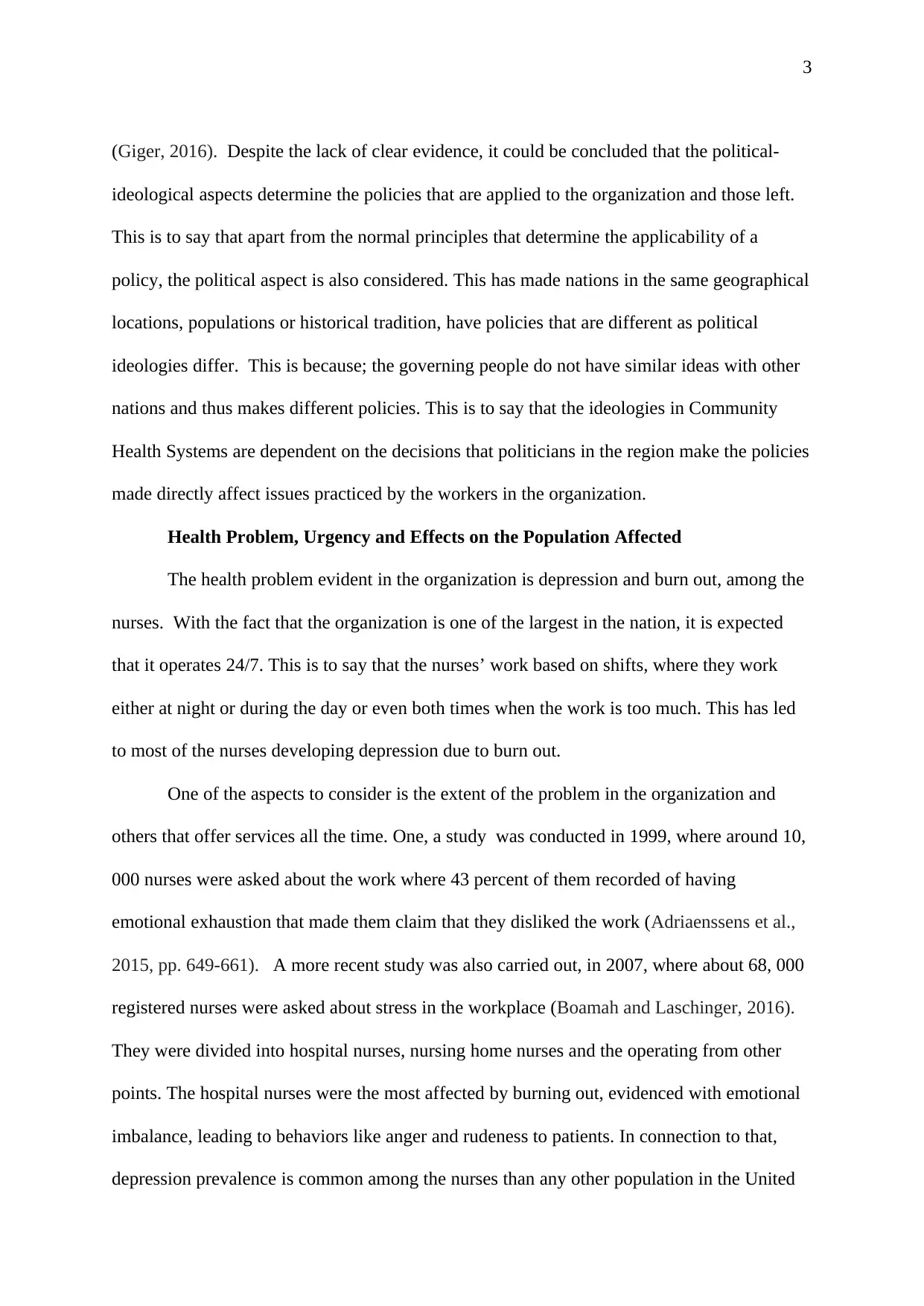
3
(Giger, 2016). Despite the lack of clear evidence, it could be concluded that the political-
ideological aspects determine the policies that are applied to the organization and those left.
This is to say that apart from the normal principles that determine the applicability of a
policy, the political aspect is also considered. This has made nations in the same geographical
locations, populations or historical tradition, have policies that are different as political
ideologies differ. This is because; the governing people do not have similar ideas with other
nations and thus makes different policies. This is to say that the ideologies in Community
Health Systems are dependent on the decisions that politicians in the region make the policies
made directly affect issues practiced by the workers in the organization.
Health Problem, Urgency and Effects on the Population Affected
The health problem evident in the organization is depression and burn out, among the
nurses. With the fact that the organization is one of the largest in the nation, it is expected
that it operates 24/7. This is to say that the nurses’ work based on shifts, where they work
either at night or during the day or even both times when the work is too much. This has led
to most of the nurses developing depression due to burn out.
One of the aspects to consider is the extent of the problem in the organization and
others that offer services all the time. One, a study was conducted in 1999, where around 10,
000 nurses were asked about the work where 43 percent of them recorded of having
emotional exhaustion that made them claim that they disliked the work (Adriaenssens et al.,
2015, pp. 649-661). A more recent study was also carried out, in 2007, where about 68, 000
registered nurses were asked about stress in the workplace (Boamah and Laschinger, 2016).
They were divided into hospital nurses, nursing home nurses and the operating from other
points. The hospital nurses were the most affected by burning out, evidenced with emotional
imbalance, leading to behaviors like anger and rudeness to patients. In connection to that,
depression prevalence is common among the nurses than any other population in the United
(Giger, 2016). Despite the lack of clear evidence, it could be concluded that the political-
ideological aspects determine the policies that are applied to the organization and those left.
This is to say that apart from the normal principles that determine the applicability of a
policy, the political aspect is also considered. This has made nations in the same geographical
locations, populations or historical tradition, have policies that are different as political
ideologies differ. This is because; the governing people do not have similar ideas with other
nations and thus makes different policies. This is to say that the ideologies in Community
Health Systems are dependent on the decisions that politicians in the region make the policies
made directly affect issues practiced by the workers in the organization.
Health Problem, Urgency and Effects on the Population Affected
The health problem evident in the organization is depression and burn out, among the
nurses. With the fact that the organization is one of the largest in the nation, it is expected
that it operates 24/7. This is to say that the nurses’ work based on shifts, where they work
either at night or during the day or even both times when the work is too much. This has led
to most of the nurses developing depression due to burn out.
One of the aspects to consider is the extent of the problem in the organization and
others that offer services all the time. One, a study was conducted in 1999, where around 10,
000 nurses were asked about the work where 43 percent of them recorded of having
emotional exhaustion that made them claim that they disliked the work (Adriaenssens et al.,
2015, pp. 649-661). A more recent study was also carried out, in 2007, where about 68, 000
registered nurses were asked about stress in the workplace (Boamah and Laschinger, 2016).
They were divided into hospital nurses, nursing home nurses and the operating from other
points. The hospital nurses were the most affected by burning out, evidenced with emotional
imbalance, leading to behaviors like anger and rudeness to patients. In connection to that,
depression prevalence is common among the nurses than any other population in the United
⊘ This is a preview!⊘
Do you want full access?
Subscribe today to unlock all pages.

Trusted by 1+ million students worldwide
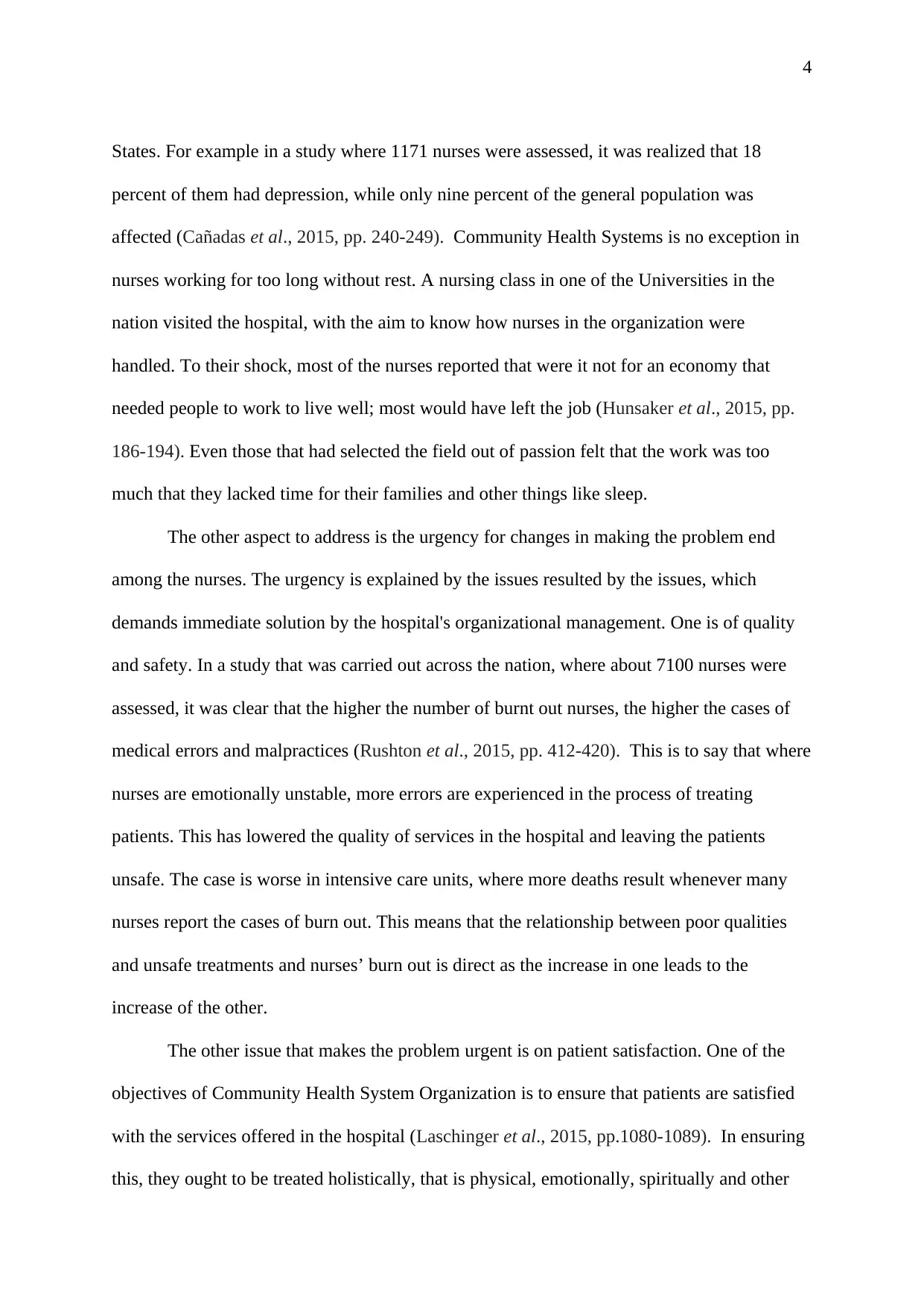
4
States. For example in a study where 1171 nurses were assessed, it was realized that 18
percent of them had depression, while only nine percent of the general population was
affected (Cañadas et al., 2015, pp. 240-249). Community Health Systems is no exception in
nurses working for too long without rest. A nursing class in one of the Universities in the
nation visited the hospital, with the aim to know how nurses in the organization were
handled. To their shock, most of the nurses reported that were it not for an economy that
needed people to work to live well; most would have left the job (Hunsaker et al., 2015, pp.
186-194). Even those that had selected the field out of passion felt that the work was too
much that they lacked time for their families and other things like sleep.
The other aspect to address is the urgency for changes in making the problem end
among the nurses. The urgency is explained by the issues resulted by the issues, which
demands immediate solution by the hospital's organizational management. One is of quality
and safety. In a study that was carried out across the nation, where about 7100 nurses were
assessed, it was clear that the higher the number of burnt out nurses, the higher the cases of
medical errors and malpractices (Rushton et al., 2015, pp. 412-420). This is to say that where
nurses are emotionally unstable, more errors are experienced in the process of treating
patients. This has lowered the quality of services in the hospital and leaving the patients
unsafe. The case is worse in intensive care units, where more deaths result whenever many
nurses report the cases of burn out. This means that the relationship between poor qualities
and unsafe treatments and nurses’ burn out is direct as the increase in one leads to the
increase of the other.
The other issue that makes the problem urgent is on patient satisfaction. One of the
objectives of Community Health System Organization is to ensure that patients are satisfied
with the services offered in the hospital (Laschinger et al., 2015, pp.1080-1089). In ensuring
this, they ought to be treated holistically, that is physical, emotionally, spiritually and other
States. For example in a study where 1171 nurses were assessed, it was realized that 18
percent of them had depression, while only nine percent of the general population was
affected (Cañadas et al., 2015, pp. 240-249). Community Health Systems is no exception in
nurses working for too long without rest. A nursing class in one of the Universities in the
nation visited the hospital, with the aim to know how nurses in the organization were
handled. To their shock, most of the nurses reported that were it not for an economy that
needed people to work to live well; most would have left the job (Hunsaker et al., 2015, pp.
186-194). Even those that had selected the field out of passion felt that the work was too
much that they lacked time for their families and other things like sleep.
The other aspect to address is the urgency for changes in making the problem end
among the nurses. The urgency is explained by the issues resulted by the issues, which
demands immediate solution by the hospital's organizational management. One is of quality
and safety. In a study that was carried out across the nation, where about 7100 nurses were
assessed, it was clear that the higher the number of burnt out nurses, the higher the cases of
medical errors and malpractices (Rushton et al., 2015, pp. 412-420). This is to say that where
nurses are emotionally unstable, more errors are experienced in the process of treating
patients. This has lowered the quality of services in the hospital and leaving the patients
unsafe. The case is worse in intensive care units, where more deaths result whenever many
nurses report the cases of burn out. This means that the relationship between poor qualities
and unsafe treatments and nurses’ burn out is direct as the increase in one leads to the
increase of the other.
The other issue that makes the problem urgent is on patient satisfaction. One of the
objectives of Community Health System Organization is to ensure that patients are satisfied
with the services offered in the hospital (Laschinger et al., 2015, pp.1080-1089). In ensuring
this, they ought to be treated holistically, that is physical, emotionally, spiritually and other
Paraphrase This Document
Need a fresh take? Get an instant paraphrase of this document with our AI Paraphraser
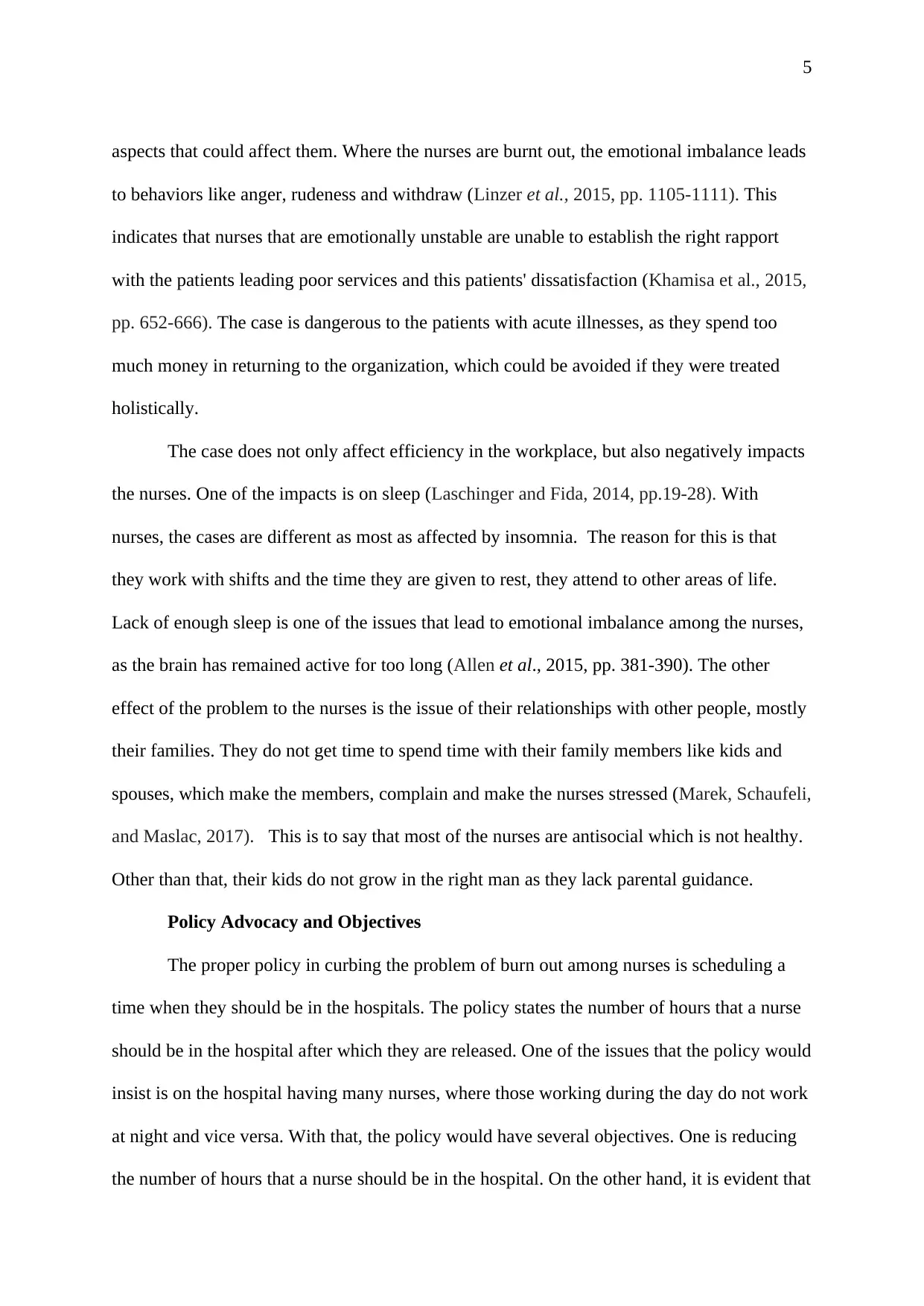
5
aspects that could affect them. Where the nurses are burnt out, the emotional imbalance leads
to behaviors like anger, rudeness and withdraw (Linzer et al., 2015, pp. 1105-1111). This
indicates that nurses that are emotionally unstable are unable to establish the right rapport
with the patients leading poor services and this patients' dissatisfaction (Khamisa et al., 2015,
pp. 652-666). The case is dangerous to the patients with acute illnesses, as they spend too
much money in returning to the organization, which could be avoided if they were treated
holistically.
The case does not only affect efficiency in the workplace, but also negatively impacts
the nurses. One of the impacts is on sleep (Laschinger and Fida, 2014, pp.19-28). With
nurses, the cases are different as most as affected by insomnia. The reason for this is that
they work with shifts and the time they are given to rest, they attend to other areas of life.
Lack of enough sleep is one of the issues that lead to emotional imbalance among the nurses,
as the brain has remained active for too long (Allen et al., 2015, pp. 381-390). The other
effect of the problem to the nurses is the issue of their relationships with other people, mostly
their families. They do not get time to spend time with their family members like kids and
spouses, which make the members, complain and make the nurses stressed (Marek, Schaufeli,
and Maslac, 2017). This is to say that most of the nurses are antisocial which is not healthy.
Other than that, their kids do not grow in the right man as they lack parental guidance.
Policy Advocacy and Objectives
The proper policy in curbing the problem of burn out among nurses is scheduling a
time when they should be in the hospitals. The policy states the number of hours that a nurse
should be in the hospital after which they are released. One of the issues that the policy would
insist is on the hospital having many nurses, where those working during the day do not work
at night and vice versa. With that, the policy would have several objectives. One is reducing
the number of hours that a nurse should be in the hospital. On the other hand, it is evident that
aspects that could affect them. Where the nurses are burnt out, the emotional imbalance leads
to behaviors like anger, rudeness and withdraw (Linzer et al., 2015, pp. 1105-1111). This
indicates that nurses that are emotionally unstable are unable to establish the right rapport
with the patients leading poor services and this patients' dissatisfaction (Khamisa et al., 2015,
pp. 652-666). The case is dangerous to the patients with acute illnesses, as they spend too
much money in returning to the organization, which could be avoided if they were treated
holistically.
The case does not only affect efficiency in the workplace, but also negatively impacts
the nurses. One of the impacts is on sleep (Laschinger and Fida, 2014, pp.19-28). With
nurses, the cases are different as most as affected by insomnia. The reason for this is that
they work with shifts and the time they are given to rest, they attend to other areas of life.
Lack of enough sleep is one of the issues that lead to emotional imbalance among the nurses,
as the brain has remained active for too long (Allen et al., 2015, pp. 381-390). The other
effect of the problem to the nurses is the issue of their relationships with other people, mostly
their families. They do not get time to spend time with their family members like kids and
spouses, which make the members, complain and make the nurses stressed (Marek, Schaufeli,
and Maslac, 2017). This is to say that most of the nurses are antisocial which is not healthy.
Other than that, their kids do not grow in the right man as they lack parental guidance.
Policy Advocacy and Objectives
The proper policy in curbing the problem of burn out among nurses is scheduling a
time when they should be in the hospitals. The policy states the number of hours that a nurse
should be in the hospital after which they are released. One of the issues that the policy would
insist is on the hospital having many nurses, where those working during the day do not work
at night and vice versa. With that, the policy would have several objectives. One is reducing
the number of hours that a nurse should be in the hospital. On the other hand, it is evident that
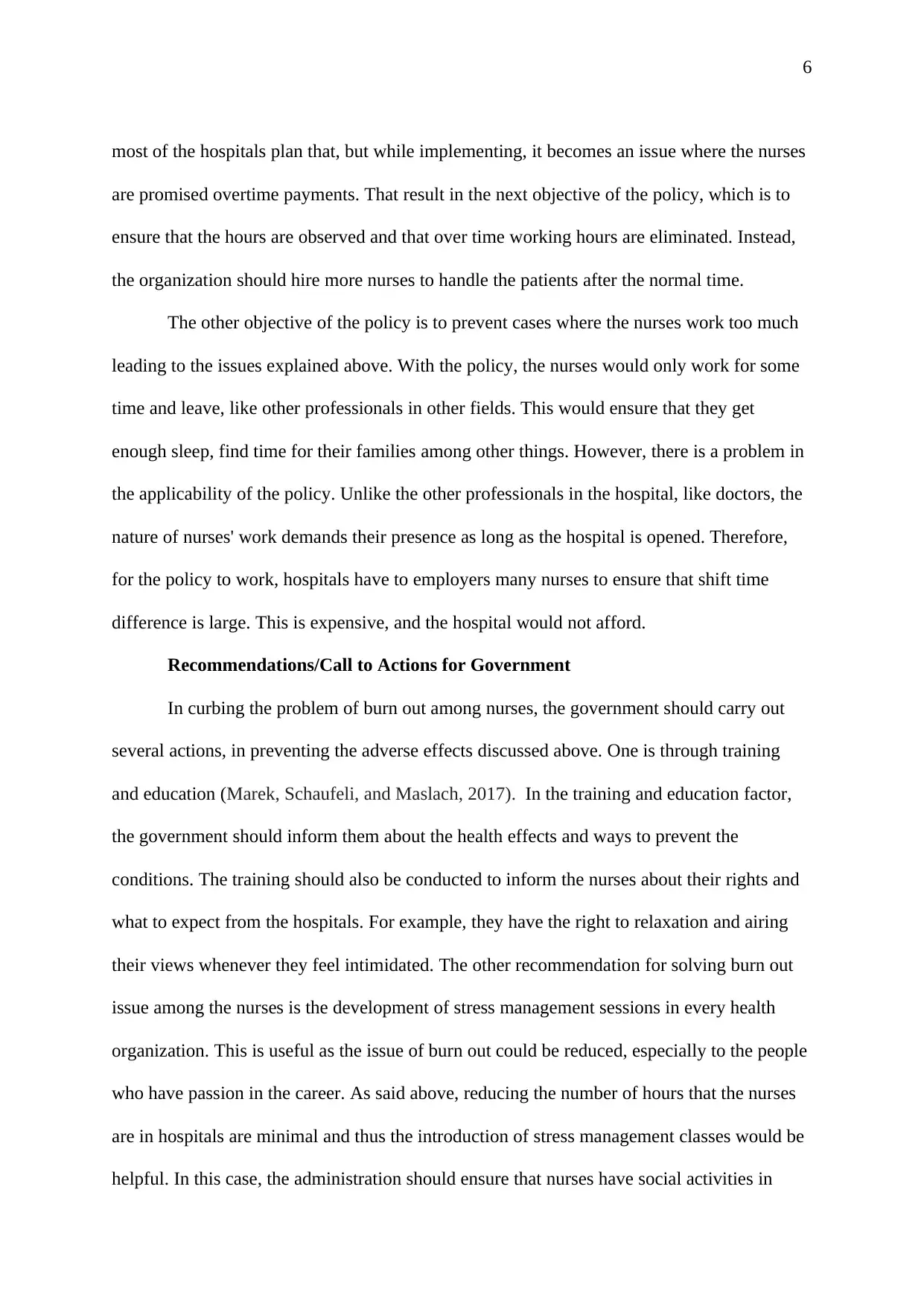
6
most of the hospitals plan that, but while implementing, it becomes an issue where the nurses
are promised overtime payments. That result in the next objective of the policy, which is to
ensure that the hours are observed and that over time working hours are eliminated. Instead,
the organization should hire more nurses to handle the patients after the normal time.
The other objective of the policy is to prevent cases where the nurses work too much
leading to the issues explained above. With the policy, the nurses would only work for some
time and leave, like other professionals in other fields. This would ensure that they get
enough sleep, find time for their families among other things. However, there is a problem in
the applicability of the policy. Unlike the other professionals in the hospital, like doctors, the
nature of nurses' work demands their presence as long as the hospital is opened. Therefore,
for the policy to work, hospitals have to employers many nurses to ensure that shift time
difference is large. This is expensive, and the hospital would not afford.
Recommendations/Call to Actions for Government
In curbing the problem of burn out among nurses, the government should carry out
several actions, in preventing the adverse effects discussed above. One is through training
and education (Marek, Schaufeli, and Maslach, 2017). In the training and education factor,
the government should inform them about the health effects and ways to prevent the
conditions. The training should also be conducted to inform the nurses about their rights and
what to expect from the hospitals. For example, they have the right to relaxation and airing
their views whenever they feel intimidated. The other recommendation for solving burn out
issue among the nurses is the development of stress management sessions in every health
organization. This is useful as the issue of burn out could be reduced, especially to the people
who have passion in the career. As said above, reducing the number of hours that the nurses
are in hospitals are minimal and thus the introduction of stress management classes would be
helpful. In this case, the administration should ensure that nurses have social activities in
most of the hospitals plan that, but while implementing, it becomes an issue where the nurses
are promised overtime payments. That result in the next objective of the policy, which is to
ensure that the hours are observed and that over time working hours are eliminated. Instead,
the organization should hire more nurses to handle the patients after the normal time.
The other objective of the policy is to prevent cases where the nurses work too much
leading to the issues explained above. With the policy, the nurses would only work for some
time and leave, like other professionals in other fields. This would ensure that they get
enough sleep, find time for their families among other things. However, there is a problem in
the applicability of the policy. Unlike the other professionals in the hospital, like doctors, the
nature of nurses' work demands their presence as long as the hospital is opened. Therefore,
for the policy to work, hospitals have to employers many nurses to ensure that shift time
difference is large. This is expensive, and the hospital would not afford.
Recommendations/Call to Actions for Government
In curbing the problem of burn out among nurses, the government should carry out
several actions, in preventing the adverse effects discussed above. One is through training
and education (Marek, Schaufeli, and Maslach, 2017). In the training and education factor,
the government should inform them about the health effects and ways to prevent the
conditions. The training should also be conducted to inform the nurses about their rights and
what to expect from the hospitals. For example, they have the right to relaxation and airing
their views whenever they feel intimidated. The other recommendation for solving burn out
issue among the nurses is the development of stress management sessions in every health
organization. This is useful as the issue of burn out could be reduced, especially to the people
who have passion in the career. As said above, reducing the number of hours that the nurses
are in hospitals are minimal and thus the introduction of stress management classes would be
helpful. In this case, the administration should ensure that nurses have social activities in
⊘ This is a preview!⊘
Do you want full access?
Subscribe today to unlock all pages.

Trusted by 1+ million students worldwide
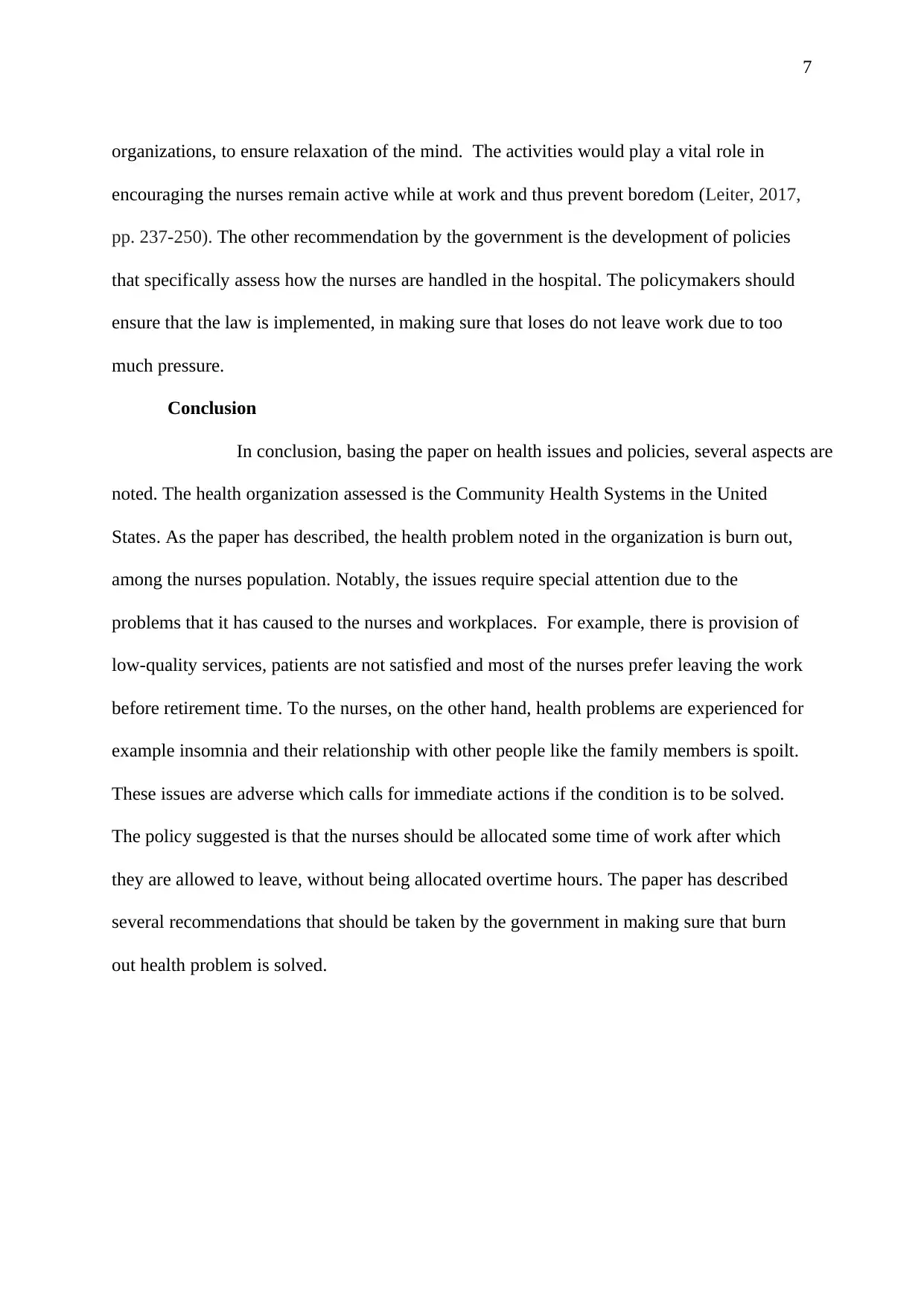
7
organizations, to ensure relaxation of the mind. The activities would play a vital role in
encouraging the nurses remain active while at work and thus prevent boredom (Leiter, 2017,
pp. 237-250). The other recommendation by the government is the development of policies
that specifically assess how the nurses are handled in the hospital. The policymakers should
ensure that the law is implemented, in making sure that loses do not leave work due to too
much pressure.
Conclusion
In conclusion, basing the paper on health issues and policies, several aspects are
noted. The health organization assessed is the Community Health Systems in the United
States. As the paper has described, the health problem noted in the organization is burn out,
among the nurses population. Notably, the issues require special attention due to the
problems that it has caused to the nurses and workplaces. For example, there is provision of
low-quality services, patients are not satisfied and most of the nurses prefer leaving the work
before retirement time. To the nurses, on the other hand, health problems are experienced for
example insomnia and their relationship with other people like the family members is spoilt.
These issues are adverse which calls for immediate actions if the condition is to be solved.
The policy suggested is that the nurses should be allocated some time of work after which
they are allowed to leave, without being allocated overtime hours. The paper has described
several recommendations that should be taken by the government in making sure that burn
out health problem is solved.
organizations, to ensure relaxation of the mind. The activities would play a vital role in
encouraging the nurses remain active while at work and thus prevent boredom (Leiter, 2017,
pp. 237-250). The other recommendation by the government is the development of policies
that specifically assess how the nurses are handled in the hospital. The policymakers should
ensure that the law is implemented, in making sure that loses do not leave work due to too
much pressure.
Conclusion
In conclusion, basing the paper on health issues and policies, several aspects are
noted. The health organization assessed is the Community Health Systems in the United
States. As the paper has described, the health problem noted in the organization is burn out,
among the nurses population. Notably, the issues require special attention due to the
problems that it has caused to the nurses and workplaces. For example, there is provision of
low-quality services, patients are not satisfied and most of the nurses prefer leaving the work
before retirement time. To the nurses, on the other hand, health problems are experienced for
example insomnia and their relationship with other people like the family members is spoilt.
These issues are adverse which calls for immediate actions if the condition is to be solved.
The policy suggested is that the nurses should be allocated some time of work after which
they are allowed to leave, without being allocated overtime hours. The paper has described
several recommendations that should be taken by the government in making sure that burn
out health problem is solved.
Paraphrase This Document
Need a fresh take? Get an instant paraphrase of this document with our AI Paraphraser
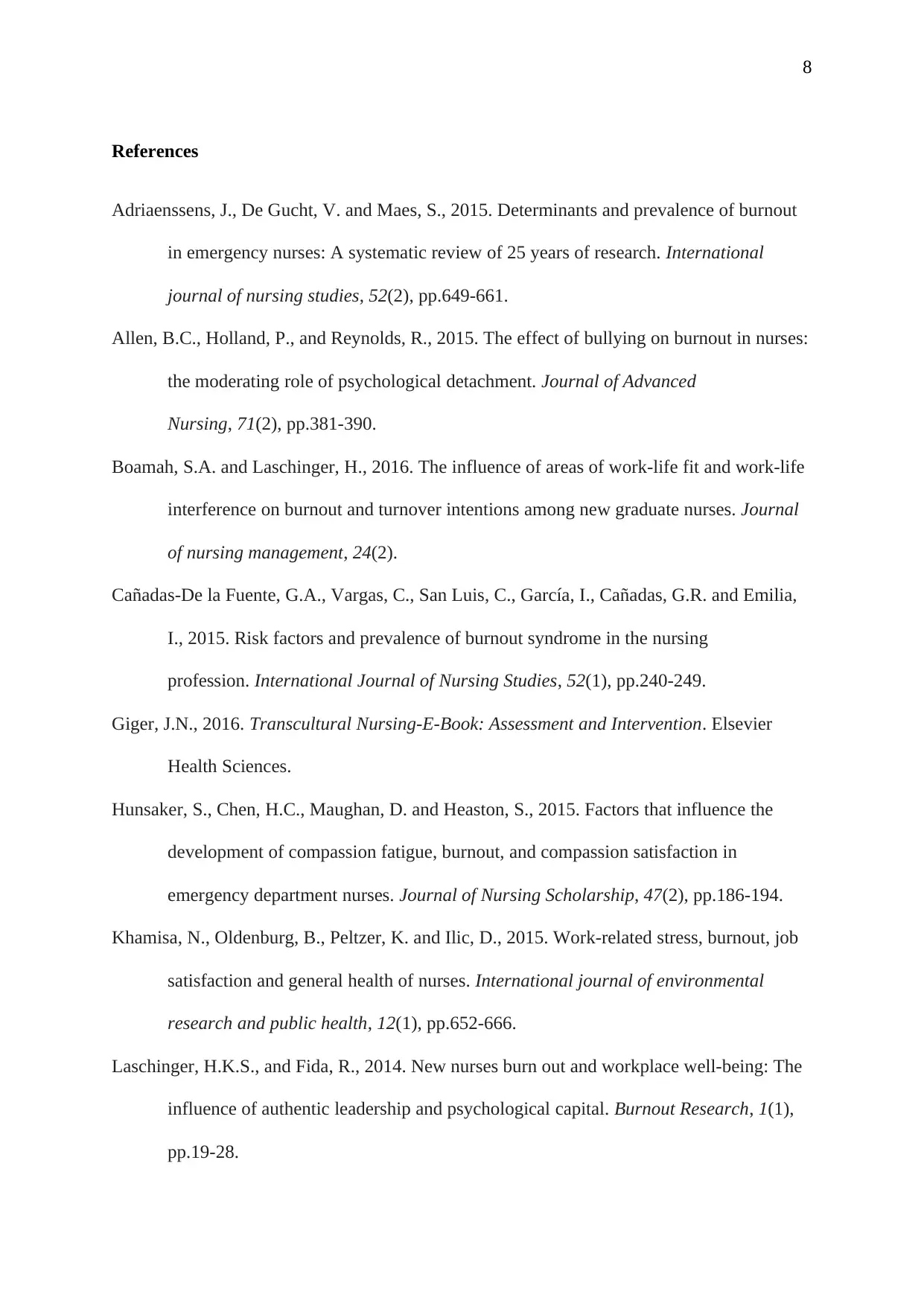
8
References
Adriaenssens, J., De Gucht, V. and Maes, S., 2015. Determinants and prevalence of burnout
in emergency nurses: A systematic review of 25 years of research. International
journal of nursing studies, 52(2), pp.649-661.
Allen, B.C., Holland, P., and Reynolds, R., 2015. The effect of bullying on burnout in nurses:
the moderating role of psychological detachment. Journal of Advanced
Nursing, 71(2), pp.381-390.
Boamah, S.A. and Laschinger, H., 2016. The influence of areas of work-life fit and work‐life
interference on burnout and turnover intentions among new graduate nurses. Journal
of nursing management, 24(2).
Cañadas-De la Fuente, G.A., Vargas, C., San Luis, C., García, I., Cañadas, G.R. and Emilia,
I., 2015. Risk factors and prevalence of burnout syndrome in the nursing
profession. International Journal of Nursing Studies, 52(1), pp.240-249.
Giger, J.N., 2016. Transcultural Nursing-E-Book: Assessment and Intervention. Elsevier
Health Sciences.
Hunsaker, S., Chen, H.C., Maughan, D. and Heaston, S., 2015. Factors that influence the
development of compassion fatigue, burnout, and compassion satisfaction in
emergency department nurses. Journal of Nursing Scholarship, 47(2), pp.186-194.
Khamisa, N., Oldenburg, B., Peltzer, K. and Ilic, D., 2015. Work-related stress, burnout, job
satisfaction and general health of nurses. International journal of environmental
research and public health, 12(1), pp.652-666.
Laschinger, H.K.S., and Fida, R., 2014. New nurses burn out and workplace well-being: The
influence of authentic leadership and psychological capital. Burnout Research, 1(1),
pp.19-28.
References
Adriaenssens, J., De Gucht, V. and Maes, S., 2015. Determinants and prevalence of burnout
in emergency nurses: A systematic review of 25 years of research. International
journal of nursing studies, 52(2), pp.649-661.
Allen, B.C., Holland, P., and Reynolds, R., 2015. The effect of bullying on burnout in nurses:
the moderating role of psychological detachment. Journal of Advanced
Nursing, 71(2), pp.381-390.
Boamah, S.A. and Laschinger, H., 2016. The influence of areas of work-life fit and work‐life
interference on burnout and turnover intentions among new graduate nurses. Journal
of nursing management, 24(2).
Cañadas-De la Fuente, G.A., Vargas, C., San Luis, C., García, I., Cañadas, G.R. and Emilia,
I., 2015. Risk factors and prevalence of burnout syndrome in the nursing
profession. International Journal of Nursing Studies, 52(1), pp.240-249.
Giger, J.N., 2016. Transcultural Nursing-E-Book: Assessment and Intervention. Elsevier
Health Sciences.
Hunsaker, S., Chen, H.C., Maughan, D. and Heaston, S., 2015. Factors that influence the
development of compassion fatigue, burnout, and compassion satisfaction in
emergency department nurses. Journal of Nursing Scholarship, 47(2), pp.186-194.
Khamisa, N., Oldenburg, B., Peltzer, K. and Ilic, D., 2015. Work-related stress, burnout, job
satisfaction and general health of nurses. International journal of environmental
research and public health, 12(1), pp.652-666.
Laschinger, H.K.S., and Fida, R., 2014. New nurses burn out and workplace well-being: The
influence of authentic leadership and psychological capital. Burnout Research, 1(1),
pp.19-28.
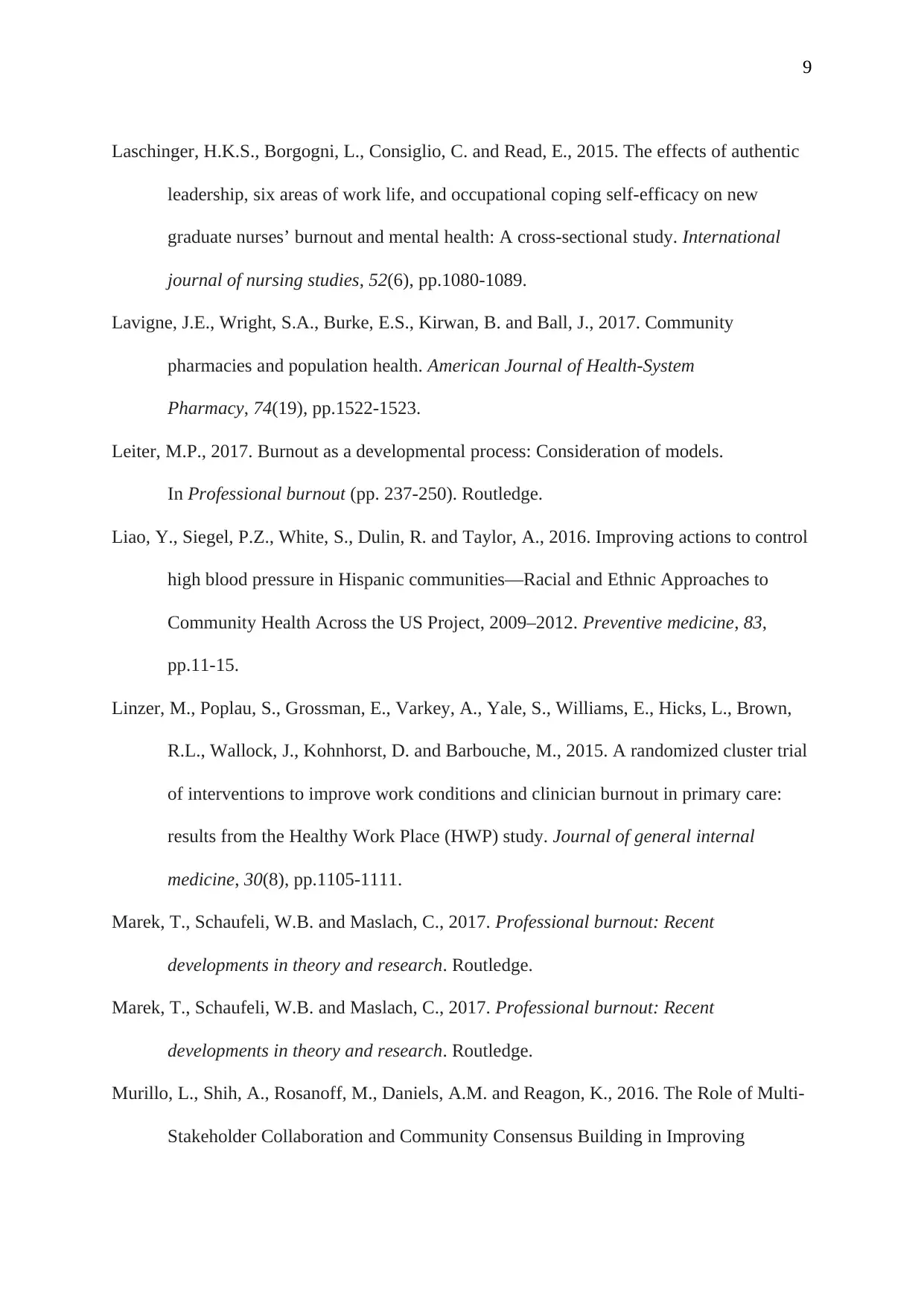
9
Laschinger, H.K.S., Borgogni, L., Consiglio, C. and Read, E., 2015. The effects of authentic
leadership, six areas of work life, and occupational coping self-efficacy on new
graduate nurses’ burnout and mental health: A cross-sectional study. International
journal of nursing studies, 52(6), pp.1080-1089.
Lavigne, J.E., Wright, S.A., Burke, E.S., Kirwan, B. and Ball, J., 2017. Community
pharmacies and population health. American Journal of Health-System
Pharmacy, 74(19), pp.1522-1523.
Leiter, M.P., 2017. Burnout as a developmental process: Consideration of models.
In Professional burnout (pp. 237-250). Routledge.
Liao, Y., Siegel, P.Z., White, S., Dulin, R. and Taylor, A., 2016. Improving actions to control
high blood pressure in Hispanic communities—Racial and Ethnic Approaches to
Community Health Across the US Project, 2009–2012. Preventive medicine, 83,
pp.11-15.
Linzer, M., Poplau, S., Grossman, E., Varkey, A., Yale, S., Williams, E., Hicks, L., Brown,
R.L., Wallock, J., Kohnhorst, D. and Barbouche, M., 2015. A randomized cluster trial
of interventions to improve work conditions and clinician burnout in primary care:
results from the Healthy Work Place (HWP) study. Journal of general internal
medicine, 30(8), pp.1105-1111.
Marek, T., Schaufeli, W.B. and Maslach, C., 2017. Professional burnout: Recent
developments in theory and research. Routledge.
Marek, T., Schaufeli, W.B. and Maslach, C., 2017. Professional burnout: Recent
developments in theory and research. Routledge.
Murillo, L., Shih, A., Rosanoff, M., Daniels, A.M. and Reagon, K., 2016. The Role of Multi‐
Stakeholder Collaboration and Community Consensus Building in Improving
Laschinger, H.K.S., Borgogni, L., Consiglio, C. and Read, E., 2015. The effects of authentic
leadership, six areas of work life, and occupational coping self-efficacy on new
graduate nurses’ burnout and mental health: A cross-sectional study. International
journal of nursing studies, 52(6), pp.1080-1089.
Lavigne, J.E., Wright, S.A., Burke, E.S., Kirwan, B. and Ball, J., 2017. Community
pharmacies and population health. American Journal of Health-System
Pharmacy, 74(19), pp.1522-1523.
Leiter, M.P., 2017. Burnout as a developmental process: Consideration of models.
In Professional burnout (pp. 237-250). Routledge.
Liao, Y., Siegel, P.Z., White, S., Dulin, R. and Taylor, A., 2016. Improving actions to control
high blood pressure in Hispanic communities—Racial and Ethnic Approaches to
Community Health Across the US Project, 2009–2012. Preventive medicine, 83,
pp.11-15.
Linzer, M., Poplau, S., Grossman, E., Varkey, A., Yale, S., Williams, E., Hicks, L., Brown,
R.L., Wallock, J., Kohnhorst, D. and Barbouche, M., 2015. A randomized cluster trial
of interventions to improve work conditions and clinician burnout in primary care:
results from the Healthy Work Place (HWP) study. Journal of general internal
medicine, 30(8), pp.1105-1111.
Marek, T., Schaufeli, W.B. and Maslach, C., 2017. Professional burnout: Recent
developments in theory and research. Routledge.
Marek, T., Schaufeli, W.B. and Maslach, C., 2017. Professional burnout: Recent
developments in theory and research. Routledge.
Murillo, L., Shih, A., Rosanoff, M., Daniels, A.M. and Reagon, K., 2016. The Role of Multi‐
Stakeholder Collaboration and Community Consensus Building in Improving
⊘ This is a preview!⊘
Do you want full access?
Subscribe today to unlock all pages.

Trusted by 1+ million students worldwide
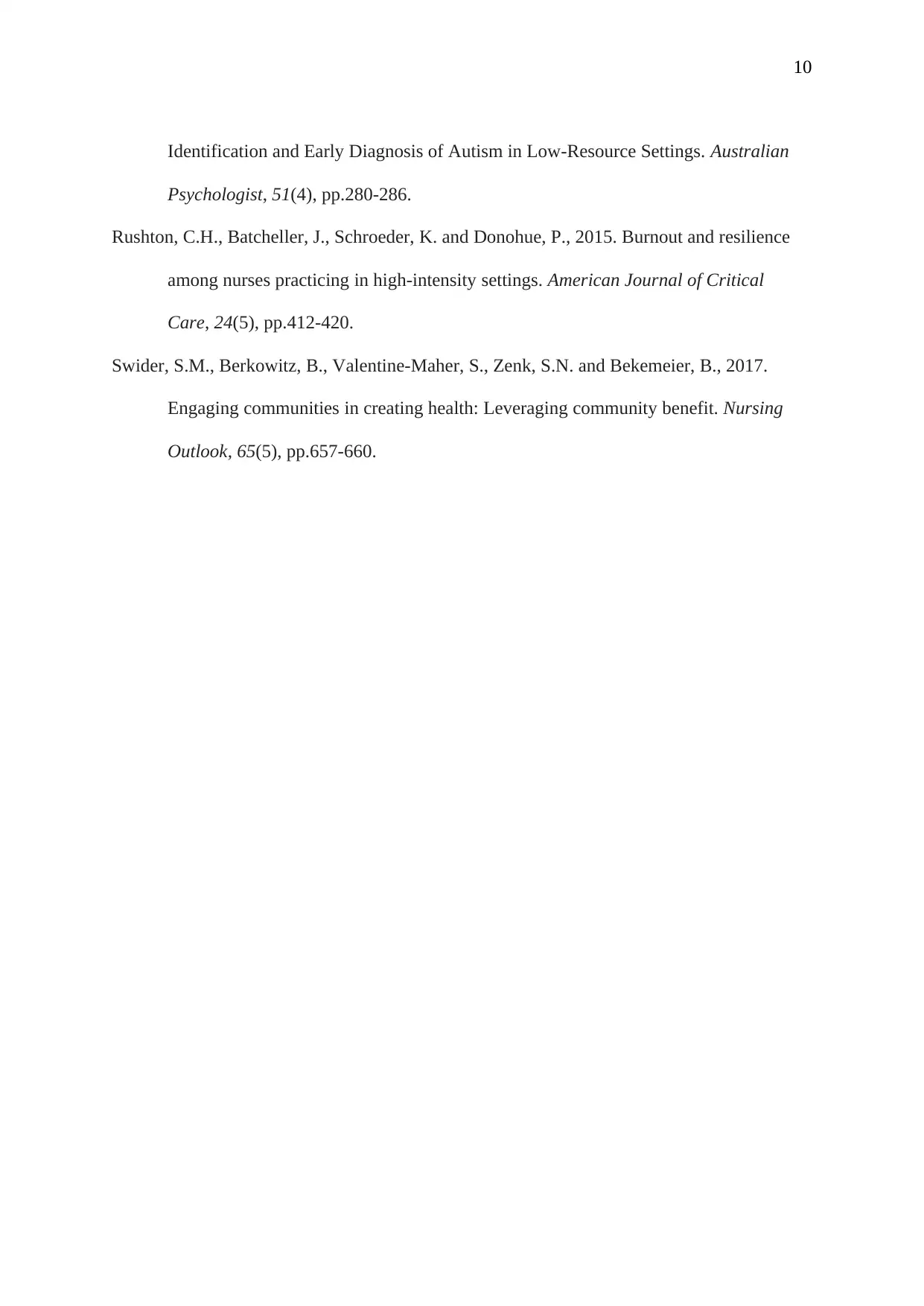
10
Identification and Early Diagnosis of Autism in Low‐Resource Settings. Australian
Psychologist, 51(4), pp.280-286.
Rushton, C.H., Batcheller, J., Schroeder, K. and Donohue, P., 2015. Burnout and resilience
among nurses practicing in high-intensity settings. American Journal of Critical
Care, 24(5), pp.412-420.
Swider, S.M., Berkowitz, B., Valentine-Maher, S., Zenk, S.N. and Bekemeier, B., 2017.
Engaging communities in creating health: Leveraging community benefit. Nursing
Outlook, 65(5), pp.657-660.
Identification and Early Diagnosis of Autism in Low‐Resource Settings. Australian
Psychologist, 51(4), pp.280-286.
Rushton, C.H., Batcheller, J., Schroeder, K. and Donohue, P., 2015. Burnout and resilience
among nurses practicing in high-intensity settings. American Journal of Critical
Care, 24(5), pp.412-420.
Swider, S.M., Berkowitz, B., Valentine-Maher, S., Zenk, S.N. and Bekemeier, B., 2017.
Engaging communities in creating health: Leveraging community benefit. Nursing
Outlook, 65(5), pp.657-660.
1 out of 10
Related Documents
Your All-in-One AI-Powered Toolkit for Academic Success.
+13062052269
info@desklib.com
Available 24*7 on WhatsApp / Email
![[object Object]](/_next/static/media/star-bottom.7253800d.svg)
Unlock your academic potential
Copyright © 2020–2025 A2Z Services. All Rights Reserved. Developed and managed by ZUCOL.




